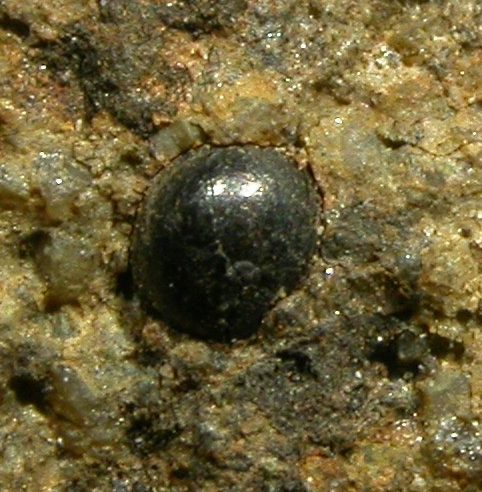Pachytheca
The Pachytheca
 |
| A Pachytheca from Gileppe, Belgium Diameter - 2 mm |
Pachytheca is hypothesized to be a genus of possible early land plants. Pachytheca lived from the Silurian to the middle Devonian era. The specimens that have been discovered have measured from 1 mm to 6mm in diameter, and have a special internal structure. Pachytheca are spherical and have two different areas. The inner area called the medulla consists of tightly packed brittle tubes. The outer area, dubbed the "bark", consists of radially arranged stronger tubes.
| The internal structure of a Pachytheca |
The Pachytheca was named by a man called J. D. Hooker in 1853. When first discovered, they were thought to be seed-like objects or a part of a fishes jaw. In 1889, J. D. took the spheres for colonies of algae, and are now classified as a Nematophyte, which is a group of puzzling organisms. Nematophytes are a group of land organisms that include plants and algae. They are only known in the fossil record as existing from the Silurian period, to the early - middle Devonian period. This definition fits in perfectly to the Pachytheca's genus. Other organisms of this group are known as Prototaxites, Nematoplexus, and Nematothallus. All are pictured below.
| What Prototaxites probably looked like (these are really interesting and I'll probably do a spotlight on them later on) |
| Nematoplexus |
| Nematothallus |
The history of Pachytheca has been foggy and full of speculation. One speculation is that the Pachytheca was an unsuccessful try of green algae trying to move to land. This makes sense, as the structure would be optimized for the least water loss. But, the algae idea was regarded as unsubstantiated, as it was put in the "Enigmatic Organisms" genus. This is because it has many features in common with Nematophytes like the ones I showed above. The idea that so many ancient plants and algae are so closely similar, or related is amazing, and makes you think of where they originated and broke off from. But, even with the uncertainty clouding the Pachytheca's habitat, it was most likely a terrestrial organism.


Comments
Post a Comment